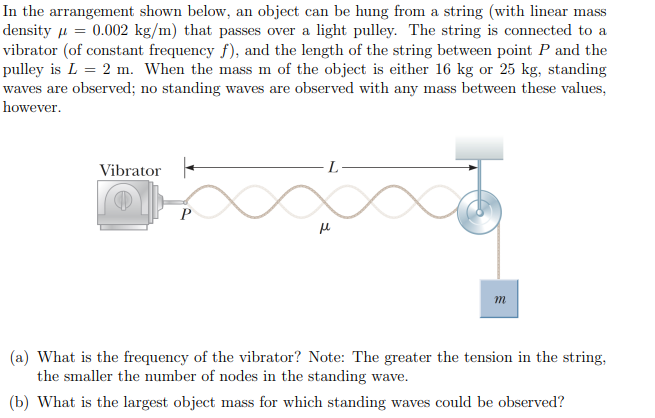In the arrangement shown below, an object can be hung from a string (with linear mass density µ = 0.002 kg/m) that passes over a light pulley. The string is connected to a vibrator (of constant frequency f), and the length of the string between point P and the pulley is L = 2 m. When the mass m of the object is either 16 kg or 25 kg, standing waves are observed; no standing waves are observed with any mass between these values, however. L Vibrator P (a) What is the frequency of the vibrator? Note: The greater the tension in the string, the smaller the umber of nodes in the standing wave. (b) What is the largest object mass for which standing waves could be observed?
In the arrangement shown below, an object can be hung from a string (with linear mass density µ = 0.002 kg/m) that passes over a light pulley. The string is connected to a vibrator (of constant frequency f), and the length of the string between point P and the pulley is L = 2 m. When the mass m of the object is either 16 kg or 25 kg, standing waves are observed; no standing waves are observed with any mass between these values, however. L Vibrator P (a) What is the frequency of the vibrator? Note: The greater the tension in the string, the smaller the umber of nodes in the standing wave. (b) What is the largest object mass for which standing waves could be observed?
University Physics Volume 1
18th Edition
ISBN:9781938168277
Author:William Moebs, Samuel J. Ling, Jeff Sanny
Publisher:William Moebs, Samuel J. Ling, Jeff Sanny
Chapter16: Waves
Section: Chapter Questions
Problem 111P: Two sinusoidal waves with identical wavelengths and amplitudes travel in opposite directions along a...
Related questions
Question

Transcribed Image Text:In the arrangement shown below, an object can be hung from a string (with linear mass
density u = 0.002 kg/m) that passes over a light pulley. The string is connected to a
vibrator (of constant frequency f), and the length of the string between point P and the
pulley is L = 2 m. When the mass m of the object is either 16 kg or 25 kg, standing
waves are observed; no standing waves are observed with any mass between these values,
however.
Vibrator +
m
(a) What is the frequency of the vibrator? Note: The greater the tension in the string,
the smaller the number of nodes in the standing wave.
(b) What is the largest object mass for which standing waves could be observed?
Expert Solution
This question has been solved!
Explore an expertly crafted, step-by-step solution for a thorough understanding of key concepts.
This is a popular solution!
Trending now
This is a popular solution!
Step by step
Solved in 2 steps

Knowledge Booster
Learn more about
Need a deep-dive on the concept behind this application? Look no further. Learn more about this topic, physics and related others by exploring similar questions and additional content below.Recommended textbooks for you

University Physics Volume 1
Physics
ISBN:
9781938168277
Author:
William Moebs, Samuel J. Ling, Jeff Sanny
Publisher:
OpenStax - Rice University

Classical Dynamics of Particles and Systems
Physics
ISBN:
9780534408961
Author:
Stephen T. Thornton, Jerry B. Marion
Publisher:
Cengage Learning

University Physics Volume 1
Physics
ISBN:
9781938168277
Author:
William Moebs, Samuel J. Ling, Jeff Sanny
Publisher:
OpenStax - Rice University

Classical Dynamics of Particles and Systems
Physics
ISBN:
9780534408961
Author:
Stephen T. Thornton, Jerry B. Marion
Publisher:
Cengage Learning